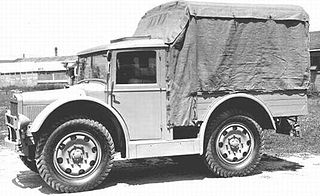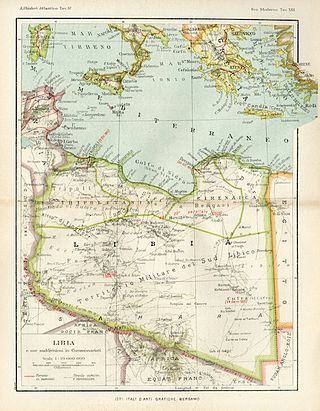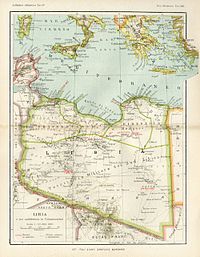
A technical, known as a non-standard tactical vehicle (NSTV) in United States military parlance, is a light improvised fighting vehicle, typically an open-backed civilian pickup truck or four-wheel drive vehicle modified to mount SALWs and heavy weaponry, such as a machine gun, automatic grenade launcher, anti-aircraft autocannon, rotary cannon, anti-tank weapon, anti-tank gun, ATGM, mortar, multiple rocket launcher, recoilless rifle, or other support weapon, etc.

The Long Range Desert Group (LRDG) was a reconnaissance and raiding unit of the British Army during the Second World War.
Patrick Andrew Clayton DSO MBE was a British surveyor and soldier. He was the basis for the character of Peter Madox in The English Patient.

Operation Compass was the first large British military operation of the Western Desert Campaign (1940–1943) during the Second World War. British, Empire and Commonwealth forces attacked Italian forces of the 10th Army in western Egypt and Cyrenaica, the eastern province of Libya, from December 1940 to February 1941.
Breda-SAFAT was an Italian weapons manufacturer of the 1930s and 1940s that designed and produced a range of machine-guns and cannon primarily for use in aircraft. Based on the M1919 Browning machine gun, the Italian guns were chambered to fire indigenous ammunition with 7.7 mm (0.303 in) and 12.7 mm (0.500 in) calibres, predominantly ball, tracer for the 7.7mm, including high explosive incendiary tracer (HEI-T), or armour-piercing (AP) for the 12.7mm.

The Frontier Wire was a 271 km (168 mi) obstacle in Italian Libya, along the length of the border of British-held Egypt, running from El Ramleh, in the Gulf of Sollum south to Jaghbub parallel to the 25th meridian east, the Libya–Egypt and Libya–Sudan borders. The frontier wire and its line of covering forts was built by the Italians during the Second Italo-Senussi War (1923–1931), as a defensive system to contain the Senussi population, who crossed from Egypt during their resistance against Italian colonisers.

The Mitragliatrice Breda calibro 8 modello 37 was an Italian Medium machine gun produced by Breda and adopted in 1937 by the Royal Italian Army. It was the standard heavy machine gun for the Royal Italian Army during World War II, and continued to be used by the Italian Army after the conflict.

The Capture of Kufra was part of the Allied Western Desert Campaign during the Second World War. Kufra is a group of oases in the Kufra District of south-eastern Cyrenaica in the Libyan Desert. In 1940, it was part of the colony of Italian Libya Libia Italiana, which was part of Africa Settentrionale Italiana (ASI), which had been established in 1934. With some early assistance from the British Long Range Desert Group, Kufra was besieged from 31 January to 1 March 1941 by Free French forces which forced the surrender of the Italian and Libyan garrison.

The Breda 20/65 mod.35, also simply known as 20 mm Breda or Breda Model 35, among other variations, was an Italian 20 mm (0.787 in) anti-aircraft gun produced by the Società Italiana Ernesto Breda of Brescia company during the 1930s and early 1940s. It saw heavy usage during the Spanish Civil War and World War II, among other conflicts. It was designed in 1932 and adopted by the Italian armed forces in 1935, becoming one of two major 20 mm caliber anti-aircraft guns used by Italy during World War II, along with the Scotti-Isotta Fraschini 20/70, both of which fired the Swiss 20x138mmB "Solothurn Long" cartridge.

The Italian invasion of Egypt was an offensive in the Second World War, against British, Commonwealth and Free French in the neutral Kingdom of Egypt. The invasion by the Italian 10th Army ended border skirmishing on the frontier and began the Western Desert Campaign (1940–1943) proper. The Italian strategy was to advance from Libya along the Egyptian coast to seize the Suez Canal. After numerous delays, the scope of the offensive was reduced to an advance as far as Sidi Barrani and the engagement of any British forces in the area.

The Maletti Group(Italian: Raggruppamento Maletti) was an ad hoc mechanised unit formed by the Italian Royal Army in Italian North Africa, during the initial stages of the Western Desert Campaign of the Second World War. The Italian army had three armoured divisions in Europe but all were needed for the occupation of Albania and the forthcoming invasion of Greece, which began on 28 October 1940. The Raggruppamento Maletti was formed in June 1940, as part of the 10th Army and contained all of the M11/39 medium tanks in Libya.

Operation Caravan was a subsidiary of Operation Agreement under which four simultaneous raids were carried out against important Axis lines of communication positions in September 1942.

The Camionetta Desertica Model 42 was an Italian reconnaissance car of World War II. The AS.42 was developed by SPA-Viberti using the same chassis as the AB 41 armoured car, including its four-wheel steering, but with a 2x4 transmission specifically for desert operations, primarily in a reconnaissance role. Its origins trace back to requests stemming from units operating on the North African front for a long range, highly maneuverable vehicle, similar to those widely used by the highly successful British reconnaissance and raiding force, the Long Range Desert Group (LRDG).

The SPA AS.37 was an Italian military light truck, used during World War II. The AS.37 Autocarro Sahariano was developed from 1937 on the frame of the TL.37 artillery tractor and was especially conceived to be employed in the North African desert. The most significant improvement of this new vehicle was its increased range: 900 km with added water tanks. The A.S.37 could transport 8 men and their equipment in its rear cargo box.

The Southern Military Territory was a jurisdictional territory within the Italian colonies of Cyrenaica and Tripolitania (1911-1934) and later Italian Libya (1934–1947), administered by the Italian military in the Libyan Sahara.

The Carro Armato M Celere Sahariano or M16/43 was a prototype medium tank developed by the Kingdom of Italy during World War II to match the speed and firepower of contemporary British cruiser tanks encountered by Italian forces during the Western Desert Campaign. The project was cancelled following the expulsion of Axis forces from North Africa in May 1943. Had it entered service, the tank's designation would likely have been M16/43: "M" for Medio, "16" representing the vehicle's weight in metric tons and "43" being the planned year of introduction.

Tanks have been employed by the military forces in Italy since their first use in World War I. They have had continued use in wars after and are still used through the modern day. The C1 Ariete is the current main battle tank of the Italian Army.

The Ascari del Cielo were the first paratroopers of the Italian Armed Forces. They all were born in Libya and with Arab-Berber ethnicity. They constituted the majority of the troops of the Battalion "Fanti dell'Aria", created in 1938, that fought in the Desert War during World War II.

The Saharan Mounted Companies of the Foreign Legion consisted of legionnaires of various nationalities and races transferred from the existing Foreign Legion infantry and cavalry regiments. These units were different from the Saharan Méharistes Companies.


















